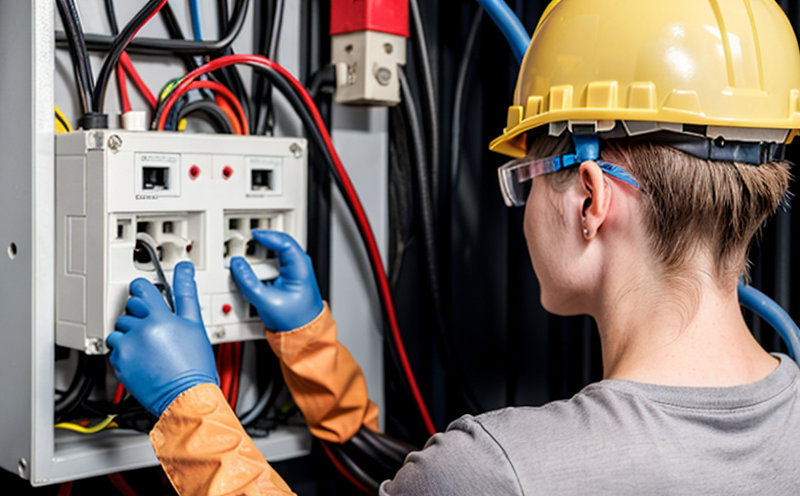IEC 61000 Electromagnetic Compatibility Testing of Smart Home Devices
The International Electrotechnical Commission (IEC) Standard IEC 61000-4 series provides a framework for electromagnetic compatibility (EMC) testing, ensuring that electronic devices do not generate excessive emissions and are immune to the electromagnetic disturbances they encounter. This service focuses on compliance with these standards specifically in the context of smart home devices.
Smart home devices encompass a wide range of products, from smart thermostats and lighting systems to security cameras and voice assistants. The growing prevalence of these devices has increased the need for rigorous EMC testing to ensure they operate reliably without causing interference or being affected by other electronic devices within the home environment.
The IEC 61000-4 series includes several parts, each addressing different aspects of electromagnetic compatibility:
- IEC 61000-4-2: Voltage changes and frequency variations
- IEC 61000-4-3: Electrical fast transients/bursts/impulses
- IEC 61000-4-4: Surge (impulse) immunity
- IEC 61000-4-5: Electrostatic discharge
- IEC 61000-4-6: Radio frequency interference susceptibility
- IEC 61000-4-8: Electromagnetic compatibility immunity aspects for medical devices and equipment
- IEC 61000-4-9: Electrostatic discharge immunity for household appliances, equipment and similar apparatus
In the context of smart home devices, IEC 61000-4-2 to -4-8 are particularly relevant. These standards ensure that devices can withstand various types of electromagnetic interference without malfunctioning or causing harmful emissions.
The testing process involves a series of rigorous steps to simulate real-world conditions and ensure the device's compliance with international standards:
- Preparation: Devices are carefully prepared for testing, ensuring they meet initial specifications and are in optimal condition.
- Test Setup: Testing facilities replicate various environmental conditions, including temperature ranges, humidity levels, and electromagnetic interference.
- Testing Procedures: A combination of laboratory-based tests and real-world simulations is conducted. This includes frequency sweeps, emission measurements, susceptibility assessments, and more.
- Data Analysis: Results are meticulously analyzed to determine compliance with IEC standards.
- Reporting: Comprehensive reports detailing the testing process and results are provided to clients.
The benefits of this service extend beyond mere compliance; it enhances product reliability, improves user satisfaction, and ensures that smart home devices integrate seamlessly into existing environments. By adhering to IEC 61000 standards, manufacturers can gain a competitive edge in the market by demonstrating their commitment to quality and safety.
Our team of experts uses state-of-the-art equipment and follows the latest guidelines to ensure accurate and reliable testing results. This service is particularly valuable for R&D engineers, compliance officers, and procurement specialists who are responsible for ensuring that products meet international standards.
Environmental and Sustainability Contributions
The implementation of IEC 61000-4 standards in smart home devices has significant environmental benefits. By reducing electromagnetic interference, these devices contribute to a cleaner environment by minimizing the need for repeated product replacements due to malfunctions or emissions.
In addition to environmental contributions, this service also supports sustainability goals within organizations. Compliance with IEC 61000 standards ensures that products are reliable and efficient, which reduces waste and resource consumption over their lifecycle.
By ensuring that smart home devices operate efficiently without causing interference, the industry can move towards a more sustainable future. This not only benefits the environment but also enhances user experience by providing reliable and consistent performance.
The testing process itself is conducted in an environmentally responsible manner, with a focus on energy efficiency and minimizing waste generation. Our laboratory uses advanced technologies that minimize resource consumption while delivering accurate test results.
Competitive Advantage and Market Impact
Compliance with IEC 61000-4 standards is crucial for manufacturers aiming to penetrate competitive markets. By ensuring that their products meet international standards, companies can gain a significant advantage in the global market.
The growing demand for smart home devices has created new opportunities and challenges for manufacturers. Meeting EMC requirements demonstrates a company's commitment to quality and safety, which enhances brand reputation and customer trust. This, in turn, translates into increased market share and customer loyalty.
Moreover, compliance with IEC standards opens doors to international markets where stringent regulatory requirements are enforced. By ensuring that products meet these standards, manufacturers can expand their global footprint without facing legal or reputational risks.
The testing process also provides valuable insights into product performance under various conditions. This information is invaluable for R&D teams in refining and improving product designs. The data collected during testing can be used to identify areas for improvement, optimize product features, and enhance overall user experience.
By leveraging the expertise of our team of engineers and the latest testing technologies, we help manufacturers stay ahead of the competition. Our comprehensive service ensures that products not only meet but exceed international standards, providing a strong foundation for market success.
Use Cases and Application Examples
The IEC 61000-4 series is applicable to various types of smart home devices. Here are some examples of how this service can be applied:
Smart Thermostats: Ensuring that the thermostat does not interfere with other wireless devices in the home and remains immune to external electromagnetic interference.
Smart Lighting Systems: Testing for interference between different lighting systems within a single household or across multiple homes, ensuring reliable operation without causing unwanted emissions.
Security Cameras: Verifying that security cameras are not affected by other electronic devices and do not cause interference with neighboring devices.
Voice Assistants: Ensuring that voice assistants operate reliably in environments with high electromagnetic interference, such as near large appliances or within dense networks of smart home devices.
Smart Appliances: Testing the compatibility between different brands and models of smart appliances to ensure they can coexist without causing interference or malfunctioning due to external emissions.
In each case, our testing process ensures that the device operates reliably under a wide range of conditions, providing peace of mind for users. This service is particularly valuable for manufacturers who are developing innovative products that integrate seamlessly into smart home ecosystems.





